————-
DARUMA DOLLS
達磨
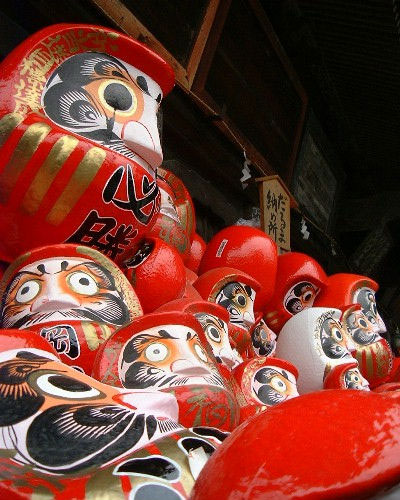
 One of the most popular talismans of good luck in modern Japan is the armless, legless, and eyeless Daruma doll, or tumbler doll . Sold at temple festivals and fairs, such dolls are typically made of papier-mache, painted red, and depict Bodhidharma seated in meditation. When knocked on its side, the doll pops back to the upright position (hence “tumbler” doll, or “okiagari koboshi”). The doll comes in many sizes – the standard size is larger than a basketball. While most Daruma dolls are male, some Japanese localities have female daruma (“ehime daruma” or “princess daruma”).
One of the most popular talismans of good luck in modern Japan is the armless, legless, and eyeless Daruma doll, or tumbler doll . Sold at temple festivals and fairs, such dolls are typically made of papier-mache, painted red, and depict Bodhidharma seated in meditation. When knocked on its side, the doll pops back to the upright position (hence “tumbler” doll, or “okiagari koboshi”). The doll comes in many sizes – the standard size is larger than a basketball. While most Daruma dolls are male, some Japanese localities have female daruma (“ehime daruma” or “princess daruma”).
Eye-Painting Custom
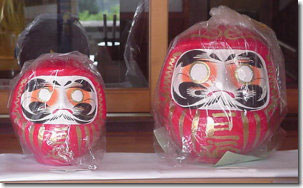
At New Year time, many Japanese individuals and corporations buy a Daruma doll,
make a resolution,
and then paint in one of the eyes.
If, during the year, they are able to achieve their goal, they paint in the second eye. Many politicians, at the beginning of an election period, will buy a Daruma doll, paint in one eye, and then, if they win the election, paint in the other eye. At year end, it is customary to take the Daruma doll to a temple, where it is burned in a big bonfire.
…
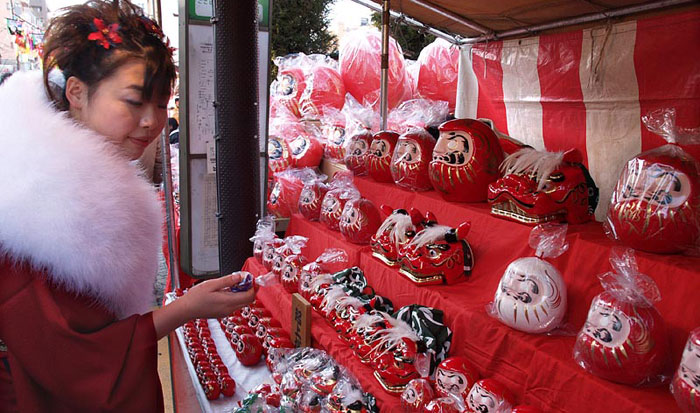
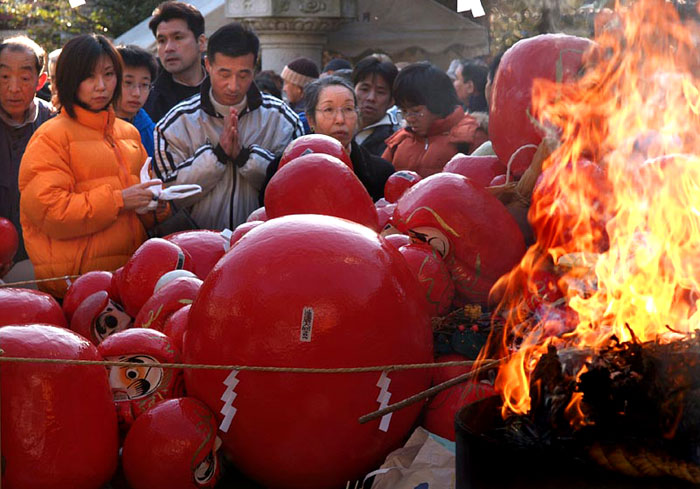
Daruma Kuyō (Daruma Kuyo) 達磨供養
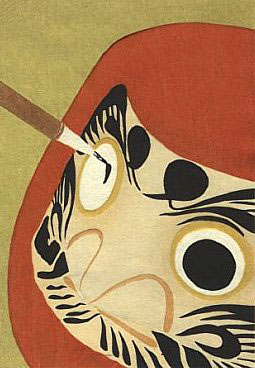
Ceremony of Offering to Daruma. “Daruma Kuyo” is a traditional event since 1954 at Nishi-Arai Daishi Temple (Tokyo), an old famous temple, the origin of which dates back to the year of 826. Daruma is a votive symbol for people wishing for the well-being of the family and flourishing business.
People bring their Daruma figures once a year on this day to the temple, express gratitude to them, and buy new ones for the next one year. The numbers of old Daruma figures are burnt together in the temple.
The ceremony of “Daruma Kuyo” is full of solemnity starting with the entrance of Buddhist monks in the style of mountain priest blowing a conch-shell horn, followed by monks in Buddhism garment, into the garden of the Komyo-den where old Daruma figures are gathered. Then the tens of thousands Daruma figures are lighted in the sounds of sutra reading by the monks.
On this same day, the bean-scattering ceremony celebrating the coming of spring is held in the Hon-den. You will also find it enjoyable to stroll along the road to the San-mon where souvenir shops, dango (Japanese sweet dumplings) shops, etc. stands in a rows.
– Source : www.tourism.metro.tokyo.jp
Daruma-ji – A Temple in Nishi Izu
達磨寺:西伊豆の散歩
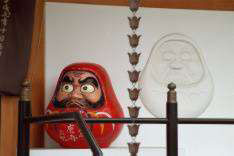
The famous Zen-priest Hakuin 白隠禅師also walked the roads of Izu Peninsula. He came to Doi and had a good look at Mt. Fuji. So the official name of this temple is “Daruma-Temple close to Mt. Look-at-Fuji”. It belongs to the group of Hoorin-ji Temple in Kyoto.
One of the famous Daruma statues in the compounds is the“Daruma to cast a vow”願掛け達磨. You write your vow on a slip of paper and paste it on the statue. On January first of every year there is a big celebration where all the slips of the past year will be consecrated.
Statue of Daruma Standing 立ち達磨大師: You can touch any part of his body which hurts on your own body and pray for good health. Daruma san is especially known for his strong legs, after all he walked quite a way if legend is true…
Usually we have a statue of Binzuru-sama ビンズルさま as a healer to touch (nadebotoke 撫で仏) You rub him on the spot where your own body hurts, but here our Daruma takes the part of the healer. Usually a Binzuru-sama has quite a well-polished, shining head …

“Life falls down seven times, yet gets up eight…”
This popular Japanese proverb is commonly associated with the Indian Buddhist sage Daruma. Daruma is the more familiar name of the historical Buddhist monk Bodhidarma, who lived sometime during the fifth or sixth century AD.
Daruma is credited with the founding of the Zen sect of Buddhism, which he is reputed to have introduced into China during his travels there. Some of the legends surrounding this figure include tales that he achieved enlightenment or satori only after meditating in a cave for seven years without blinking or moving his eyes.
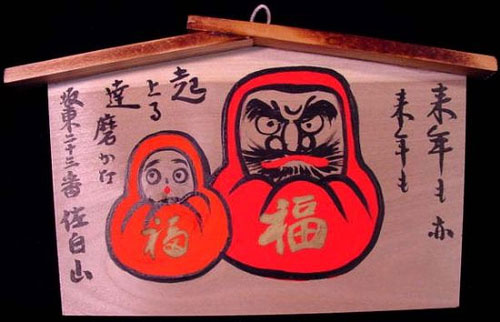
Another story tells that his enlightenment occurred within a temple in China where he spent his seven years sitting in a room staring at a wall. Apparently at some point during his long meditation Daruma became so overcome with fatigue that he cut off his eyelids in anger and tossed them to the ground. These are reputed to have then sprouted into China’s first green tea plants! It is said that Daruma’s long meditation caused his arms and legs to wither and fall off, leaving him as an armless, legless and eyelidless (yet enlightened) Bodhidarma…
The Japanese love this story and admire Daruma for his spirit and determination, and each new year many Japanese will buy a paper-mache Daruma tumbler doll in order to enlist its services in helping them persevere towards their own goals or achievements.
The dolls are sold with unpainted eyes, allowing the new owner to paint in one eye to symbolize the start of a new goal or venture. The doll is then placed in a prominent place within the home or at work in order to remind the owner to keep after their aim. Japanese students especially utilize Daruma to motivate them with their studies; placing a one-eyed Daruma before them on their desk as motivation to work hard and make the grade. Only after the goal is achieved will the owner then paint in the second eye, symbolizing a realized goal. Daruma dolls which have completed their jobs as perseverance role models are normally then brought to a temple to be burned during special ceremonies set aside for this purpose. The last images below are various representations of Daruma found at a Zen temple near our home in Japan.
– Source : www.onmarkproductions.com





Comments are closed.